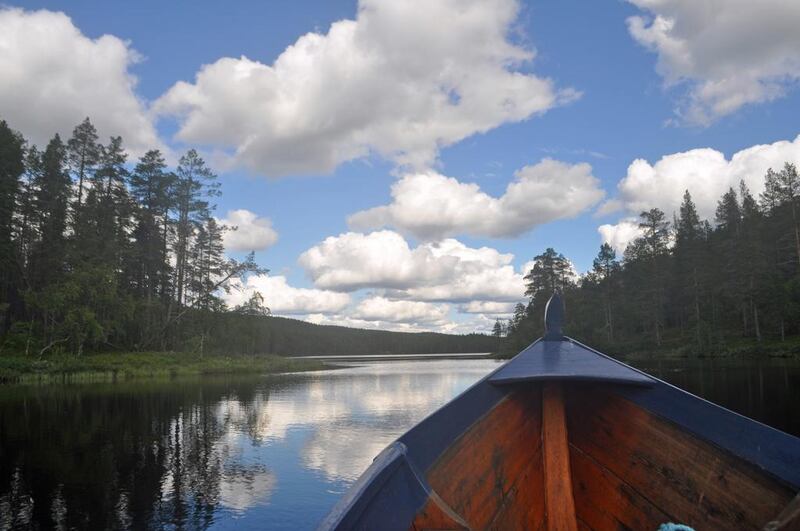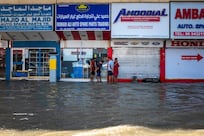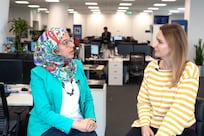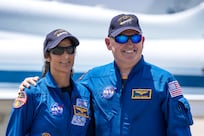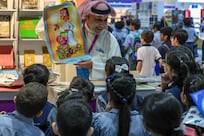‘Lapland.” As an answer to the question “where are you off to next?” it’s one that’s guaranteed to shut people up. And as confusing geographical entities go, it’s up there with Scandinavia, the Netherlands and the United Kingdom in the vague picture many people have in their minds. Especially when you tell them you’re going there in summer.
In my own head, before I visit, the image I have (mainly from seeing pictures online and imagining them without the snow), it looks like a giant farmed forest. Clean, but, well ... boring. I’ve now been twice in the past 12 months, and from the UAE, that’s a 20-hour trip each way.
Finnish Lapland (we’ll get to Lapland the region later) is an area of about 100,000 square kilometres and makes up about the top third of the country. Looking at a map of Finland, start with Helsinki near the bottom and let your gaze move up. And up. And up. That’s kind of what happened when I boarded my “direct”, 1,000-kilometre internal Finnair flight from the capital, which has a population of more than one million, to Ivalo, population 3,700. That, I realise after a few days, is a metropolis around here. The view from the plane’s window down on to snaking rivers surrounded by thick forest is good preparation. This place is wild.
I’m staying at Kakslauttanen Arctic Resort, which, given that I’m 250km north of the Arctic Circle, is no misnomer, even in 24-hour daylight. The owner, Jussi Eiramo, was returning to central Finland after a fishing trip in 1973 when he ran out of petrol and was forced to set up camp here. He fell in love with the area, and eventually leased land both sides of the main two-lane E75, and developed it as a year-round resort.
It's beautiful. Situated on the edge of the vast Urho Kekkonen National Park, 300km from the nearest traffic light, this is my kind of place. Big log cabins with no TV, phone or air con are spaced so you can't see who's nearby. Not that there are ever many others anyway. The occasional car whizzes past along that main road, but apart from that, there's a deep silence. Scenery-wise, think Moose Lake, Minnesota, from the movie Fargo. Water, trees and, when you do see them, most if not all of the men have beards.
Given more time, I’d have donned a backpack and disappeared along the well-marked trails into the fells towards the Russian border, staying at free backpackers’ huts and drinking from streams along the way.
As it is, I begin with a visit to the Gold Prospector Museum down the road in Tankavaara. Documenting the history and culture of gold prospecting, it begins with a display on ancient Egypt and moves through to the present day. A gold rush came to the area at the end of the 1800s after alluvial gold was found in the Ivalo River, though it wasn’t sustainable on a large scale and most of the companies went bankrupt. Today there’s still some gold in the river, which you can “pan” for yourself with a ridged, shallow rubber bucket that you dip into the water and then swill around, painstakingly sieving the gravelly mixture for tiny flecks of gold. Don’t give up your day job.
Back at Kakslauttanen, a delicious dinner of reindeer and blue-cheese soup, accompanied with thinly sliced, malty bread and local butter, and grilled fresh salmon – from Lake Inari up the road – awaits in the aptly named Log restaurant. With 24-hour daylight, we drive to the top of a fell at Kaunispää, near the tourist village of Saariselkä, to view the midnight sun. I’m standing on a stretch of sparse moorland with wooded fells as far as the eye can see in every direction. The soft light is like sunrise and sunset combined; later on, at 2 or 3am, it’s like a dimmer switch has turned it down.
Breakfast the next morning comprises bread, cheese and more fresh salmon – this time it’s cured, but unlike the stuff you get in most hotels, it’s soft and delicate. Afterwards, I’m met by my Sami guide, Ari, who runs a tourism business between Lapland and Barcelona. Though they’re indigenous to Lapland, most Sami, Ari explains, now live in Helsinki because of the lack of jobs in the north of the country. “Some have reindeer, but there’s not much work available if you’re well educated.” This is despite the fact that most Samis speak three or four languages, such as Northern Sami, Inari Sami, Finnish and Swedish. Most road signs are in Sami, English and Finnish; hence they read “Sapmi – Lapland – Lappi”. Because only five per cent of the entire Finnish population live here, it’s an effort to make sure languages don’t disappear.
On our way north to Inari, the conversation returns, inevitably, to reindeer, still the mainstay of traditional ways of life (another growing industry is mining, which may yet threaten both the environment and traditional culture). Signs outside supermarkets typically advertise two things: “bakery” and “reindeer”. Ari explains there are fewer than 200,000 people in Finnish Lapland, and about 250,000 reindeer. “They are wild but they belong to the herder,” says Ari. “They come to the roadside to escape from the mosquitoes. They are not afraid of cars or buses, and so they can get run over. Their antlers grow 2.5 centimetres per day.”
At the excellent Siida museum, there's much more to be learnt about Sami culture and local nature and weather patterns, including the long, dark winters, which last from October to April, and the Northern Lights, which they referred to as a "firefox" – not an internet browser, but a fox running through the snow and shaking its tail at the sky. I also learn that the region of Lapland crosses the entire northern part of Scandinavia, crossing international borders. Most Sami, about 50,000, are actually to be found in northern Norway, named, confusingly, Finnmark.
Continuing our trip north to Kirkenes, we pass tiny, ramshackle farming hamlets. Some of the wooden buildings look like they won’t last another winter. At other times, we skirt forested lakes, the only sign of human life the odd boat or kayak tied to a tree.
At the Norwegian border, there’s no passport control. Here, the forest disappears, and in a few hours we reach Kirkenes for our Hurtigruten ferry west to Honningsvåg. We’re so close to Russia that many of the road signs are in Russian; Murmansk is 225km away.
On our one-night Hurtigruten cruise, we stop at several bleakly interesting coastal settlements. Ari explains that during the Second World War, the retreating Germans burnt down most of the old wooden buildings, so most look relatively new. In contrast to Finland and Sweden, however, Ari says there are no restrictions on the colour of houses, making them attractive despite their newness. Our ship is the 1,000-passenger MS Midnatsol, one of several on the world-famous Hurtigruten line travels up and down Norway's long coastline – the service from Kirkenes began in 1908. Now mostly a tourist boat, it's still a vital way of connecting remote communities who survive on fishing and the service and mining industries.
We disembark at Honningsvag, an attractive port town, for an excursion to the North Cape, continental Europe's most northerly point. After the visitors' centre (www.nordkapp.no), there's only really a rugged cliff edge to look at, but it's a remarkable feeling to actually be standing at such an isolated point that I've looked at many times before on a map. To appreciate the area further, we take a "boat safari" around a nearby marine nature reserve, seeing several varieties of gull, eagle, seal, kittiwake, cormorant and thousands of puffins breeding in burrows on vertiginous green cliffsides. Captain Ola Thomassen tells me there are three million birds in Stuorstappen, a nearby group of islands.
After a bowl of fish soup at a local restaurant, we drive south again, over high plateaus still – in the first week of August – with patches of snow. Dark skies have gathered as we hit a coastal road, making for dramatic photographs of the sand, sea and sky. We stop for a break at a small cafe at a caravan park beside a lake, and pass meadows full of purple wildflowers.
Our last trip is to Lemmenjoki National Park (www.outdoors.fi), Finland's largest and one of northern Europe's biggest wilderness areas – and possibly its most dramatic. We take a small guided motorboat trip up the Lemmenjoki River, and it's the simplicity that gets you. The water is so clean, you can see the bottom. The pure, bright blue sky and the dark blue water are sliced in half by dark green spruce trees growing out of a glowing green bed of grass and moss, their spiky pattern reflected in the water. We clamber up a waterfall, before walking along a scenic path through the woods to a picnic spot. There, our Sami guides break into song – a less-than-melodic yoik that seems full of the babbling, onomatopoeic semi-madness that comes from a life listening to and looking at nature. We drink water straight from the lake before a lunch of reindeer and vegetable soup. Our guides tell us that the reindeer that graze through this park taste especially delicious because they feast on 350 different types of plant and mushroom species. Sure enough, as we cruise back down the river and look into the forest, we see huge mushrooms growing in the glades.
As we return to Kakslauttanen, we skirt Lake Inari, another of the area’s most beautiful spots. Many of the largest, oldest trees were taken from eastern Finland by the departing Russians after they invaded, Ari tells me, answering my question about whether or not they’re farmed. They were replanted, and now strict environmental procedures are placed on logging. In the spaces between the trees, there’s now an endless stillness. Back at the resort, we hit the world’s largest smoke sauna before jumping into the lake. With summer so short, it makes sense to make the most of them.
rbehan@thenational.ae
